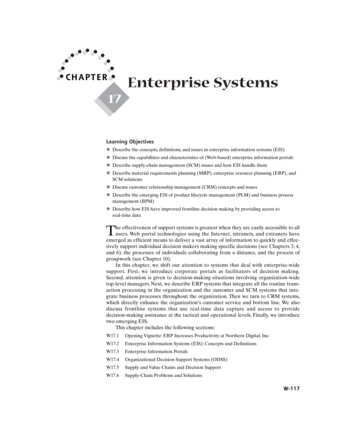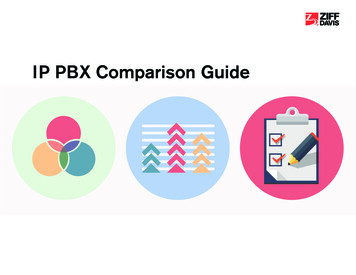
Transcription
TURBMW17 0131986600.QXD11/9/068:59 PMCHAPTERPage W-117Enterprise Systems17Learning Objectives Describe the concepts, definitions, and issues in enterprise information systems (EIS) Discuss the capabilities and characteristics of (Web-based) enterprise information portals Describe supply-chain management (SCM) issues and how EIS handle them Describe material requirements planning (MRP), enterprise resource planning (ERP), andSCM solutions Discuss customer relationship management (CRM) concepts and issues Describe the emerging EIS of product lifecycle management (PLM) and business processmanagement (BPM) Describe how EIS have improved frontline decision making by providing access toreal-time dataThe effectiveness of support systems is greatest when they are easily accessible to allusers. Web portal technologies using the Internet, intranets, and extranets haveemerged as efficient means to deliver a vast array of information to quickly and effectively support individual decision makers making specific decisions (see Chapters 3, 4,and 6), the processes of individuals collaborating from a distance, and the process ofgroupwork (see Chapter 10).In this chapter, we shift our attention to systems that deal with enterprise-widesupport. First, we introduce corporate portals as facilitators of decision making.Second, attention is given to decision-making situations involving organization-widetop-level managers. Next, we describe ERP systems that integrate all the routine transaction processing in the organization and the customer and SCM systems that integrate business processes throughout the organization. Then we turn to CRM systems,which directly enhance the organization’s customer service and bottom line. We alsodiscuss frontline systems that use real-time data capture and access to providedecision-making assistance at the tactical and operational levels. Finally, we introducetwo emerging EIS.This chapter includes the following sections:W17.1Opening Vignette: ERP Increases Productivity at Northern Digital, Inc.W17.2Enterprise Information Systems (EIS): Concepts and DefinitionsW17.3Enterprise Information PortalsW17.4Organizational Decision Support Systems (ODSS)W17.5Supply and Value Chains and Decision SupportW17.6Supply-Chain Problems and SolutionsW-117
TURBMW17 0131986600.QXD W-11811/9/068:59 PMCHAPTER 17Page W-118Enterprise SystemsW17.7MRP, ERP/ERM, and SCM SystemsW17.8Customer Relationship Management (CRM) SystemsW17.9Emerging EIS: Product Lifecycle Management (PLM) and Business ProcessManagement (BPM)W17.10 Frontline Decision Support SystemsW17.1 OPENING VIGNETTE: ERP INCREASES PRODUCTIVITYAT NORTHERN DIGITAL, INC.Northern Digital, Inc. (NDI; ndigital.com), in Ontario, Canada, is a supplier of visualmeasurement products. The relatively small company employs 90 people and generatesover 20 million in revenue annually.PROBLEMNDI faced a challenge when rapid growth and aging technology threatened to stand inthe way of the company’s goals. Instead of enabling operational improvements, NDI’sexisting systems were impeding progress. Existing technology was causing misseddeliveries and creating a large number of back orders. Inventory control was poor, andthe planning was inaccurate. With some customers expecting shipment in as long asnine months and others expecting shipment in as little as nine days or even less, moresophisticated and accurate planning was critical. Customer satisfaction was at risk, andinternal morale was slipping. With about 20 years in business, NDI’s well-establishedreputation for high-quality, high-performance products was also at risk.SOLUTIONNDI selected an ERP system from Intuitive Manufacturing Systems, based on factorsthat directly supported its corporate objectives. Intuitive’s ERP system provided a levelof system functionality that could immediately improve inventory management and theexpandability and flexibility to support NDI’s growth. The software includes a completeplanning system, automated inventory management, and enhanced technology infrastructure. Equally important were the system’s ease of implementation and use.RESULTSAfter implementing Intuitive ERP, NDI experienced continued success in improvinginventory management and increasing revenue. Prior to implementation, the companyhad struggled to achieve even two inventory “turns” (i.e., turnovers) per year.Inventory turns have now more than doubled, and expectations are that the companywill better that in the near future. Since it implemented the system, NDI’s revenue hasincreased from 10 million to over 20 million, with little increase in inventory value.In addition, the company has reduced order cycle time for its flagship product fromfour months to four weeks, an improvement of almost 80 percent. This was a result ofimproved planning capabilities due to the ERP system.Improvements in production control and inventory management have had a directimpact on customer delivery and satisfaction. The material requirements planning
TURBMW17 0131986600.QXD11/9/068:59 PMPage W-119Enterprise Information Systems (EIS): Concepts and DefinitionsW-119 (MRP) and forecasting capabilities of Intuitive ERP have allowed NDI to better service its customers. The addition of better planning capabilities had an immediate positive impact on labor and materials. “We were able to better understand what was instock, what we were buying, and what was needed,” said Tom Kane, production manager. “Improved planning has made a huge difference in improving delivery.”Ease of use and system scalability have been important in utilizing Intuitive ERPto improve operations. When the system was first implemented, NDI needed only 5user seats (i.e., user licenses). As NDI grew, that number increased to 25. Significantlyincreasing the number of users, and doing so without a great deal of training, allowedthe company to expand without worrying about putting constraints on its businessinfrastructure while supporting the growth strategy.For NDI, improving operations is more than just a way to reduce expenses. Withthe implementation of Intuitive ERP, NDI has found a way to increase the value it provides to customers while also improving financial performance.In both 2005 and 2006, NDI was called one of Canada’s Best Managed Companiesof the Year.Sources: Compiled from Northern Digital: ERP Case Study, view/393223 (accessed April 2006); and ndigital.com (2006).Questions for the Opening Vignette1. For a small company like NDI, why is an ERP system useful?2. Identify the supply-chain segments that NDI’s ERP supports; be specific.3. Identify the improvements (i.e., value added) to various parts of the NDI supplychain.4. Go to intuitivemfg.com and report on the capabilities of the company’s ERP product.WHAT WE CAN LEARN FROM THIS VIGNETTEThe opening vignette introduces the topics of ERP and SCM systems, which are systems that support tactical and strategic decision making at all levels of an organization.In many organizations, a variety of decisions are made on a daily basis by middle andtop managers, marketing analysts, and other knowledge workers in many locations,even in different countries. When decision support involves two or more departments,EIS are used.W17.2 ENTERPRISE INFORMATION SYSTEMS (EIS): CONCEPTSAND DEFINITIONSIn the 1980s and through most of the 1990s, systems serving the needs of top executiveswere designed as independent (i.e., standalone) systems and were called executive information systems.This approach made such systems affordable mostly to large corporations.Today, executives are supported by systems that support other employees as well, including business intelligence (BI), ERP, knowledge management, PLM, BPM, and CRM.Theyare called, collectively, enterprise information systems (EIS), meaning systems that servean entire enterprise, or at least two functional departments. The opening vignette demonstrates that these systems serve many users and therefore are very cost-effective.
TURBMW17 0131986600.QXD W-12011/9/068:59 PMCHAPTER 17Page W-120Enterprise SystemsTECHNOLOGY INSIGHTS W17.1CIO Spending Plans: Now and LaterThe Gartner Group surveyed 620 CIOs in January 2003to determine what priorities they had for the new year,and Merrill Lynch & Co. surveyed 50 U.S. CIOs inFebruary 2003 for their priorities when the economyimproved. Most of these spending plans involved developing EIS.These were the top 10 priorities for 2003:1. Security enhancement tools2. Application integration/middleware/messaging3. Enterprise (information) portal deployment4. Network infrastructure/management tools5. Internal e-enabling infrastructure Application integration (14 percent) Corporate (enterprise) information portals (14percent) SCM (14 percent) BI/data warehousing (DW) (12 percent) Analytic applications (e.g., DSS/business analytics[BA]) (10 percent)In 2005, these technologies were chosen accordingto a Gartner study reported by Keizer (2004): New or updated applications in business intelligence and content management6. Web design, development, and content management tools Security7. Storage management Upgrading Windows on the desktop8. CRM Server virtualization and automated provisioning9. Web services (internal and external) BPM (33 percent)10. XML-based processes/messagingThese were the most important first software projects to be funded when the economy improved: Replacing or upgrading PCs BI/data mining (28 percent) Data integration (26 percent) CRM (20 percent) CRM (20 percent) Network security (19 percent) Security (20 percent) Web services (17 percent) ERP (16 percent) Knowledge management (15 percent) Storage (16 percent) ERP (14 percent)Sources: Adapted from K. Melymuka, “Ready, Set . . . ,” Computerworld, July 21, 2003, pp. 37–38; and“CIO Insight Research Study The Future of IT,” CIO Insight, January 2005, pp. 70–77.EIS projects are expected to be a high priority item among CIOs for the next several years. See Technology Insights W17.1 for a breakdown from two surveys.The results listed in Technology Insights W17.1 clearly show the importance of EIS.In this chapter, we cover several types of EIS (other systems are covered in Chapters 3,6, 10, and 11). We begin with corporate portals, the gateway to information. Then wemove to large-scale organization systems, which leads to the concept of the supply chainand its management. Following that, we cover ERP and its predecessor systems. Next,we cover CRM. We finish the chapter by covering several high-impact, emerging EIS:process lifecycle management (PLM) and business process management (BPM).Section W17.2 Review Questions1. Define EIS.2. List typical EIS.3. Describe the importance of EIS.
TURBMW17 0131986600.QXD11/9/068:59 PMPage W-121Enterprise Information PortalsW-121 W17.3 ENTERPRISE INFORMATION PORTALSCorporate (enterprise) portals are the gateway to enterprise information that is provided by enterprise systems, including BI (see Chapters 5 through 9) and the systemsdescribed here.An enterprise (information) portal integrates internal applications, such as database management, document management, and e-mail, with external applications,such as news services and customer Web sites. It is a Web-based interface thatgives users access to all these applications through their PCs. Enterprise portals bringboth external and internal information to all employees’ desktops. They also enablecollaboration.BENEFITS, CAPABILITIES, GOALS, AND COSTS OF ENTERPRISEINFORMATION PORTALSEnterprise information portals have different capabilities, goals, and costs, as describedin the following sections.Benefits and Goals of Enterprise Information PortalsThe most important reasons for deploying an enterprise information portal (sometimes called a corporate portal) include distributing information more effectively,encouraging collaborative work, managing content and information, integrating withenterprise applications, supporting customers, supporting suppliers and partners,improving Internet administration, and reducing training costs (see Frye, 2002). Portalsprovide internal collaboration (see Lipschutz, 2003), leading to effective and fast decision making. For example, virtual communities can thrive by using enterprise information portal collaboration features, especially when members are scattered around theglobe (see Grodner, 2003).The main goal of an enterprise portal is to give each user a personalized and integrated view of business information, applications, and services. Portal users may beinternal or external to an organization (see White, 2002). Enterprise portals havediverse capabilities and therefore use several layers of multiple technologies, such asthe following: Groupware/collaboration technologies. These include discussions, chat sessions,and library projects. Presentation. These tools include data visualization tools, such as Web OLAP,JavaScript, and VBScript for Web display. Personalization and customization. These tools include software agents that customize information for individual users, using push technology. Publishing and distribution. These tools include storehouses of documents inportable formats, as well as publishing and subscription engines; content management systems are accessed via enterprise information portals. Search. These tools include both full-text search engines and those that searchdescriptions of documents and other content. Categorization. These technologies include tools for creating and maintaining different categories of information for different audiences, such as multidimensionality tools. Integration. These are tools for accessing disparate back-end data sources, suchas ERP packages, relational databases, and external data, such as stock pricequotes.
TURBMW17 0131986600.QXD W-12211/9/068:59 PMCHAPTER 17Page W-122Enterprise SystemsThe enterprise information portal has become the de facto standard We
that directly supported its corporate objectives.Intuitive’s ERP system provided a level of system functionality that could immediately improve inventory management and the expandability and flexibility to support NDI’s growth.The software includes a complete planning system, automated inventory management, and enhanced technology infra-structure. Equally important were the system’s ease of











